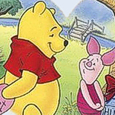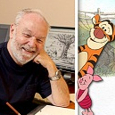Walt Disney Pictures (1977), Walt Disney Home Entertainment (June 19, 2007), single disc, 74 mins plus supplements, 1.33:1 original full frame ratio, Dolby Digital 5.1, Rated G, Retail: $29.99
Storyboard:
A.A. Milne’s classic characters are captured almost perfectly in this compilation of three classic featurettes.
The Sweatbox Review:
Imagine a time when Americans didn’t know who Winnie The Pooh was— before there were countless lamps, pyjamas, books, and plates featuring his visage; before there were kids playing Pooh CD-ROM games or watching Pooh TV shows. Yes, a dark age to be sure. But, back in the 1960s, Pooh was not a large property. He had been published in the U.S. for some time, but the Milne characters had only been partially exploited by the American license holder Stephen Slesinger. Walt Disney, however, recognized the potential in the little bear, and in turn licensed Pooh and his friends for a film version of the Milne stories. After developing the stories as an episodic feature, it was decided to go for more of a slow build and to split the feature up into three distinct featurettes. The first of these, Winnie The Pooh And The Honey Tree, was released in 1966. Two more featurettes followed in 1968 and 1974. With all three now completed and having seen increasing popularity and acclaim, the three were finally merged into the feature that had been originally planned, along with some new framing material, and The Many Adventures Of Winnie The Pooh finally came out in 1976.
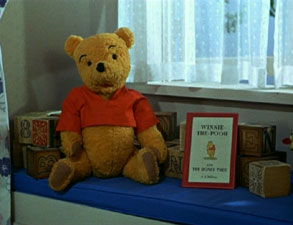
But who was this bear? The history of Winnie The Pooh can be traced back to the time of the First World War, when some Canadian soldiers were on their way through eastern Canada before being sent overseas. While in Ontario, one of the soldiers bought a bear cub from a hunter and named the bear after his hometown of Winnipeg, Manitoba, and the bear soon took the nickname of “Winnie.” The cub became a mascot of sorts to the soldier’s unit, and while in England the bear was given to the London Zoo at the end of 1919 before the soldier went to France. At the zoo, the bear was a favorite of young Christopher Robin Milne, who decided to name his own teddy bear Winnie (the teddy having previously been named Edward). Later on, his father Alan Alexander began to craft stories based on his son’s imagined adventures with his stuffed toys and nearby wild animals in Sussex…and an icon was born. The first publication of Milne’s stories in book form (following a late 1925 appearance in The London Evening News) came in 1926 A book of verses called Now We Are Six appeared in 1927, and The House At Pooh Corner was published in 1928. The Pooh stories were charmingly illustrated by E.H. Shepard, whose work perfectly captured the delicacy of youth and the whimsicalness of Milne’s writings.
The Pooh stories had been published in the United States for some time already when they became favorites of Walt Disney’s daughters. When he arranged with the widow of Slesinger to capture the Pooh stories in animation, even he likely had little inkling that Pooh would become the most profitable character in the Disney empire. Under Walt’s guidance, and the direction of Wolfgang Reitherman and John Lounsbery, the Pooh featurettes would capture the hearts of many an American child, and also found favor with the children of nations the world over. True, the adaptations were not entirely faithful— the Shepard drawings provided only vague inspiration, as designs were done to make the cast cuddlier and better to animate; the characters (except for Christopher Robin) spoke in American accents; and then there was the addition of a whole new character— but there is no denying the unbeatable charm of the resulting featurettes. As a whole or individually, they are gentle, nostalgic odes to youth that are undeniably appealing to kids of all ages.
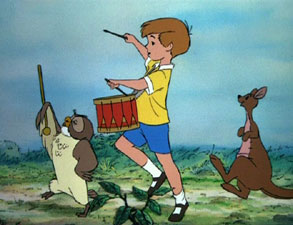
One thing I’ve always enjoyed about these shorts visually is the hand-drawn look that is so evident from the Xerox process that Disney was using at the time. Many of the animator’s own pencil marks delineating spines or coarse shapes remain on view in the figures, which seems perfectly in keeping with the feel of these cartoons as being a storybook come to life. That the animated stories retain so much of the books’ whimsical language further aids the authenticity of the tales, despite a few allowances being made in forming the adaptations. At least the voice cast is superb, led by Sterling Holloway as Pooh and “Dick Dastardly” himself, Paul Winchell, as Tigger.
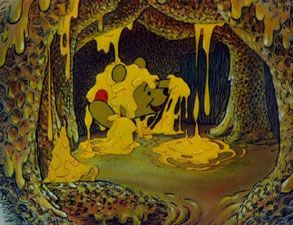
Winnie The Pooh And The Honey Tree was the first featurette, and it leads off the compilation feature. It begins with a live action look at a child’s bedroom, strewn with stuffed animals. Though the toys are Disney-fied versions, it does nicely get across the origin of these tales. A storybook opens to a familiar rendering of the Hundred Acre Wood, populated by the characters from the stories. The storybook trappings charmingly remain as a motif throughout the stories. Christopher Robin begins swinging from a tree right there on the map, followed by other characters coming to life on the page. Piglet seems oddly unrealized in his brief appearance here, due to the fact that he never appears in the rest of this story and therefore his design had not been as nailed down as it would be in the next featurette. The first of several charming songs from the Sherman Brothers begins, a simple but endearing ditty introducing Winnie The Pooh. The story that follows is by now very familiar to me, going way back to my View Master days, as those View Master reels were my first exposure to this tale. Winnie The Pooh runs out of honey at his home, and using an unusual amount of ingenuity, he borrows a balloon from Christopher Robin. He then rolls himself in the mud to disguise himself as a rain cloud, and then he uses the balloon to climb to a honey tree. The ruse fails, and he is attacked by bees.

Pooh then heads to Rabbit’s house, where he spends most of the rest of the tale, because he eats so much honey there that he is unable to fit through the hole that serves as Rabbit’s entrance. Even the brains of Owl are insufficient to extricate Pooh, and the only thing to do is to wait for Pooh to grow smaller. The aid of Gopher is enlisted, but to no avail— Wait a minute… Gopher? Where’d he come from? Well, as is repeated a couple of times in the movie, Gopher “Isn’t in the book,” and that is literally true. Gopher was created by Disney to provide the American audience with a more familiar character. As much as I love Walt, this seems fairly lame, and it is Gopher’s inclusion in lieu of Piglet that most rankles fans of the original stories. Nevertheless, the story continues otherwise as it should, with a satisfyingly enjoyable conclusion before it segues into the next story.

Winnie The Pooh And The Blustery Day sees the Hundred Acre Wood taken over by a strong wind. Gopher is back to wish Pooh a “Happy Winds-Day,” but fortunately Piglet is very much featured in this one. After flying Piglet like a kite, they encounter Owl, whose own home is soon blown over. Eeyore decides to find Owl a new home, and Pooh goes home to rest. With the wind still howling outside, Pooh hears noises that cause him concern, leading him to investigate and discover Tigger for the first time. Tigger introduces himself with a song just as catchy as Pooh’s, describing himself as the only one of his kind, and he makes certain Pooh knows how much he loves bouncing. During his visit to Pooh, he mentions Heffalumps and Woozles as the likely cause of the mysterious noises, which leads to Pooh having a dream that gives us the neatest animated dream sequence since Dumbo got loaded. Pooh awakes later in a flooded home, as the water washes letters right off the pages of the storybook. In the end, Owl receives a new home, and Pooh gains a roommate. The touching finale to the tale helped this featurette win the Oscar that year.
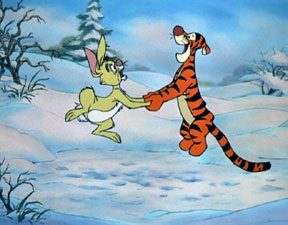
Winnie The Pooh And Tigger Too brings the spotlight onto Tigger, whose bouncing is driving Rabbit crazy. Rabbit convinces the others that Tigger must be “lost,” the plan for which only succeeds in losing Rabbit and Pooh. After saving them, Tigger continues his bouncing ways, until he bounces himself too high up in a tree and must be talked down in an interesting use of the storybook motif. Though Tigger is made to regret his bouncing ways to an extent, the moral of the story is about appreciating others for who they are. This is another winner of a cartoon, and it earned an Academy Award nomination.
The movie then ends with a lovely new coda that acknowledges Christopher Robin growing up and leaving his childhood behind. The bittersweet ending brings the feature version of these tales to a beautiful conclusion that avoids the potential pitfall of being too cloying or cute. If you are wrapped up in the movie, I would not doubt that the ending might bring a tear to your eye as you feel a twinge of regret that you ever had to grow up. It’s a fine capper to a superior trio of cartoons.

Is This Thing Loaded?
This is a “Disney Fast Play” DVD. Does anyone care? No? OK, moving on…

The Sneak Peeks that play first include those for the Jungle Book Platinum Edition (I’d have to check my laserdisc to see how the colors match up, but I have to admit it looks nice), Disney’s Princess Enchanted Tales, Little Einsteins: Rocket’s Firebird Rescue, and Handy Manny. Further Sneak Peeks may be found off the menu, including Meet The Robinsons and My Friends Tigger And Pooh, plus a promo for Disney Movie Rewards.
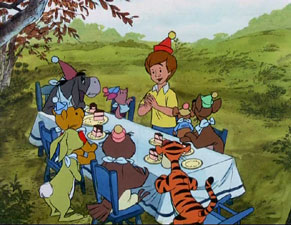
Winnie The Pooh And A Day For Eeyore (25:21) was a featurette released in 1983, several years after the compilation feature was released. While it was essential that this featurette be included on this disc for completeness’ sake, there are several things that make it an inferior production. First of all, it was not even produced at the Disney studio! It was actually farmed out to Rick Reinert Productions, the first instance of Disney doing such a thing since Harman-Ising’s Merbabies production for the studio in 1938. Alas, the Disney touch just isn’t there, though it is obvious that the creative people tried their best, even re-using some of the live action and animated framing pieces. Sterling Holloway is not present, though Paul Winchell is. Sebastian Cabot is no longer there to narrate. The staging seems off, Pooh’s eyes are a little too big, the figures are too clean, and the direction is not consistent with Reitherman’s style. It’s not a bad featurette, really, but it just feels “off.”

The Story Behind The Masterpiece (25:02), narrated by Corey Burton, has been seen on disc before, having been produced in 2001, but that is no knock against it. It’s every bit as good now as it was then, telling the story of the book and the behind-the-scenes story of the making of the featurettes. There are lots of nice interviews here, including the Sherman Brothers, Paul Winchell, and even Frank & Ollie. We also get to see some nice concept art and storyboards. Speaking of which, there is a separate Winnie The Pooh Art Gallery that offers over 50 pieces of artwork including concept art, behind the scenes photos, posters, and theme park photos. Pooh’s Pop-Up Fun Facts activates a subtitle track that features oodles of information about all things Pooh. I wish the packaging had mentioned this one, as I would have liked to have watched it when viewing the feature initially. It was a surprise to find it buried on the second page of the bonus materials menu.

The first episode of the new Pooh show is featured in the My Friends Tigger And Pooh Bonus Episode (24:03). This show is somewhat in the vein of other modern popular kiddie shows, telling simple tales with the characters directly addressing the viewer and following an established format closely. Here, Pooh and Tigger team with a young girl to become “super sleuths” in order to solve mysteries. After that, the pickings on this disc get a little less meaty. The 100 Acre Wood Challenge Game is fine for kids, and not aimed at us collectors. I don’t normally care for the new renditions of classic Disney songs often found on their DVDs, but with the Winnie The Pooh Theme Song Performed By Carly Simon (2:33), you do get a pretty good performer. Rounding out the extras are Pooh’s Shadow Disney Storytime (read-along), and The Wonderful Thing About Tiggers Sing-Along.
Case Study:
I don’t think the composition of the various elements works too well on the cover of this DVD, but I do love the coloring job that was done, which makes this a nicely nostalgic-looking package. The usual identical slip-sleeve fits over the standard keepcase. Inside is a chapter listing insert and a Disney Movie Rewards pamphlet.
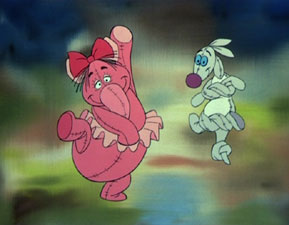
Ink And Paint:
The film is presented in its original 4:3 screen ratio (thank goodness!). Disney says the film has been remastered and restored, though I don’t know if they meant specifically for this release. Regardless, the transfer looks quite good overall, with just a little light grain visible enough of the time to remind you that you are watching a cartoon that was actually captured on film decades before it became a digital file. The source material is pretty good, with most defects coming from the original cels. Compression issues are not an issue at all. The film shows its age, but to me it is in a good way. If the transfer is just a little soft, it perfectly suits the nostalgia of Pooh.

Scratch Tracks:
The soundtrack is presented in full 5.1 sound in English, French, or Spanish, but don’t fret if you don’t have a surround sound system. At best, this sounds like a stereo track. That’s OK, though, considering that the original audio was in mono to begin with. The lovely music of the Sherman brothers, along with the now-classic renditions of Pooh and his friends by Holloway, Winchell, et al are wonderfully preserved.
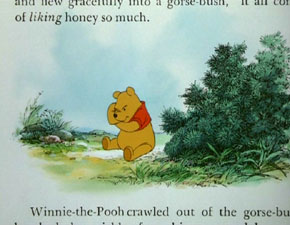
Final Cut:
There is little to differentiate this disc from the previous DVD of The Many Adventures Of Winnie The Pooh (the 25th Anniversary edition from 2002), with the only significant addition being the episode of the new Pooh program. However, if you do not already own this film, this is a recommended purchase— particularly if you have kids. For collectors, the only thing that might have made this better would have been another disc presenting the featurettes in their original form, but other than that this is a very nice disc whether you are a child or a Disney buff. Those Pooh featurettes had plenty of that ol’ Disney magic, and this compilation feature is a fairly ideal way to enjoy them.
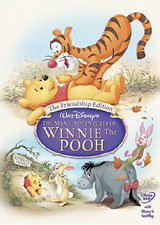 | ||
 |








